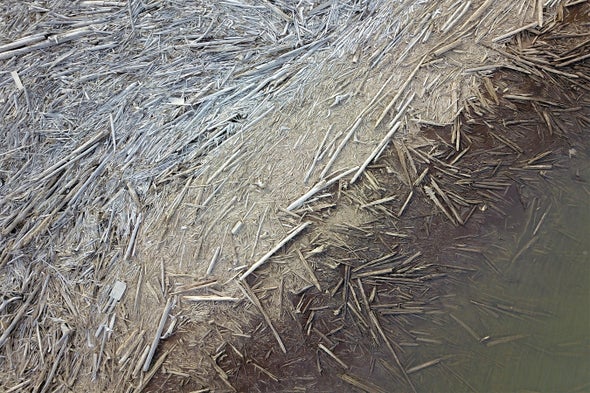CLIMATEWIRE | A mountain of driftwood in Canada's Mackenzie River is a carbon storage "hotspot."
The logjam, which covers an area roughly the size of Manhattan, could be the world's largest river deposit of dead trees and holds about 3.1 million metric tons of carbon, according to a recent study in Geophysical Research Letters. The findings provide a window into carbon cycling — the process of plants absorbing and releasing carbon — within Arctic river deltas.
“What’s unique about the Mackenzie Delta is just how much carbon is stored in these formations and how it is preserved on the landscape for such a long time,” said Alicia Sendrowski, the study’s lead author and a hydrologist and research engineer at Michigan Technological University. “That wood is just stacking up there, and some of it is being preserved for hundreds of years.”
It's widely understood that living trees are carbon sinks, absorbing and storing carbon via photosynthesis. Dead and dying trees can also hold carbon, as long as they remain submerged in water or sediment. But they become emitters of the planet-warming gas if exposed to surface elements.
"Throughout the Arctic, fallen trees make their way from forests to the ocean by way of rivers. Those logs can stack up as the river twists and turns, resulting in long-term carbon storage," researchers wrote in the study. "Wood is an important carbon-rich material that may break down differently from the finer carbon pools, however, [and] the amount of wood stored in Arctic river deltas has not been measured before."
Researchers used high-resolution satellite mapping and radiocarbon analysis to measure the logjam and age the wood. Some trees dated to the seventh century, while others were felled as recently as 2015. Roughly 40 percent of the wood samples collected were from trees that were living later than the late 1950s.
“The Arctic’s cold, often dry or icy conditions mean trees can be preserved for tens of thousands of years. A tree that fell a thousand years ago might look just as fresh as one that fell last winter,” Sendrowski said in an interview.
The Mackenzie is Canada’s longest river, running 1,100 miles in a northwesterly direction from Great Slave Lake to the Beaufort Sea. Its delta is the third largest in the world and considered an important research site for climate scientists due its carbon-dense soils. But researchers know little about carbon cycling from massive driftwood complexes in the basin.
Katherine Lininger, a geomorphologist and assistant professor of geography at the University of Colorado, said in an interview that questions about wood carbon storage in river deltas is an emerging area of interest because it allows for a deeper examination of carbon cycling across varied and complex ecosystems.
The Michigan Tech-led research will help calculate how much fallen wood is in the delta and how much of its carbon storage could be lost as the climate warms.
“As it gets eaten up by rain and ice and smashed against rocks and other pieces of wood, pieces break off and get broken down by microbes. That’s where the carbon releases would come from,” Sendrowski said.
In the study, researchers noted that wood moves during the summer, as ice breaks up. But the basin also experiences periodic “wood floods” that transport hundreds of thousands of dead trees accumulated along river banks and shorelines. Sendrowski said several major wood floods appear to have occurred over the last half of the 20th century, contributing to the large percentage of biomass from that era.
Climate change could lead to even more deadwood in the Mackenzie River — and particularly its delta, she added.
“As permafrost thaws, there’s an expectation there will be greater erosion,” she said. “That’s going to release carbon directly from the soil, as well as from buried wood in the soil. Also, more trees will be falling into the river, and those trees might have less of a chance of being captured on the landscape. They may degrade more rapidly.”
Virginia Ruiz-Villanueva, a fluvial geomorphologist at the University of Lausanne in Switzerland, said in a news release that the research will also help advance scientific understanding of carbon cycling from fallen trees.
“There’s been a lot of work on fluxes of carbon from water and sediment, but we simply didn’t pay attention to the wood until very recently," said Ruiz-Villanueva, who was not involved in the study. "This is a very young field of research that is developing quite fast."
Reprinted from E&E News with permission from POLITICO, LLC. Copyright 2023. E&E News provides essential news for energy and environment professionals.


